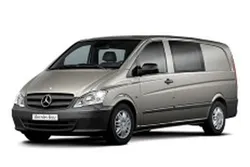

Mercedes-Benz Vito Generation 2 W639 Facelift 2010
Explore the Mercedes-Benz Vito and its Generation 2 W639 facelift from 2010, available with various options in Portugal. Discover performance, features, and pricing today.
The Mercedes-Benz Vito has been a popular choice in the light commercial vehicle segment since its inception. The second generation, known as...
Technical Specifications
Select Version
Dimensions
Engine
Driving
Others
History and Features
Mycarro AI
Apr 26, 2025
Introduction to the Mercedes-Benz Vito W639
The Mercedes-Benz Vito has been a popular choice in the light commercial vehicle segment since its inception. The second generation, known as the W639, was first introduced in 2003 and underwent a facelift in 2010. This facelift brought with it several updates, both subtly aesthetic and significantly functional, ensuring that the Vito remained appealing to a wide range of commercial users, from tradespeople to family transporters.
Design and Aesthetics
The most obvious changes in the 2010 facelift of the Vito W639 were found in its exterior design. Mercedes-Benz refined the front fascia by introducing a more modern look with redesigned headlights and a prominent grille. The bumper was also updated for a sleeker appearance, giving the Vito a more dynamic stance on the road. These changes not only enhanced the visual appeal of the vehicle but also improved aerodynamics, contributing to better fuel efficiency.
In addition to the exterior updates, the facelift also offered new color combinations and wheel designs. The cabin saw enhancements as well, with a focus on quality materials and ergonomic design. While the overall layout remained familiar, upgraded controls and improved infotainment options made the interior more appealing to both drivers and passengers.
Enhanced Performance and Efficiency
When it came to performance, the 2010 facelift introduced several engine improvements that aligned with growing environmental standards and customer expectations for efficiency. The range offered multiple diesel engines, including the 2.1-liter four-cylinder engine in various tuning levels. One of the significant highlights of the facelift was the introduction of the BlueEfficiency technology, which aimed to optimize fuel consumption and reduce CO2 emissions.
The suspension setup was also improved, which provided enhanced ride comfort and handling characteristics. With a refined chassis, the Vito offered stability on the road and was adept at handling the heavier loads typical of commercial use. This combination of efficiency and performance ensured that the Vito remained competitive in a crowded market.
Focus on Safety
The 2010 facelift also included improvements in terms of safety features, which were becoming increasingly important to consumers. The Vito W639 was equipped with an array of safety systems such as ESP (Electronic Stability Program), ABS (Anti-lock Braking System), and a driver and passenger airbag as standard. The facelift made several advanced features available, including optional parking sensors, rear-view cameras, and adaptive brake lights, ensuring that both driver and passengers felt secure.
Versatility and Configurations
One of the standout attributes of the Vito W639 generation is its versatility, and the facelift model enhanced this quality further. The van was offered in various configurations, including different lengths, heights, and weight ratings. This means that businesses could customize the vehicle according to their specific needs, whether for transport, cargo, or even as a mobile workshop.
Additionally, the rear cargo space was optimized to allow for an impressive load capacity, making the Vito a practical choice for various industries. The ability to convert the vehicle into a minibus or a family van further broadened its appeal, demonstrating that the Vito W639 was not only a workhorse but also highly adaptable for lifestyle purposes.
Conclusion
The Mercedes-Benz Vito Generation 2 (W639) facelift of 2010 played a crucial role in solidifying the vehicle's position in the competitive van market. With its updated design, improved performance, enhanced safety features, and remarkable versatility, the Vito continued to cater to the diverse needs of commercial users and families alike. As a testament to Mercedes-Benz's commitment to quality and innovation, the W639 facelift remains a significant chapter in the Vito's legacy, exemplifying how design and functionality can come together in a well-crafted vehicle.
